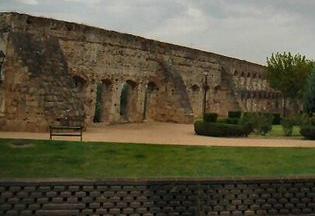 Mérida
Mérida.jpg) Mérida is the capital
city of the Autonomous region Extremadura,
and is set in the Province
of Badajoz.
Mérida is the capital
city of the Autonomous region Extremadura,
and is set in the Province
of Badajoz.
One of the most important Roman capital cities at the height of Roman occupation of Spain, the city today has one of the best preserved collection of Roman monuments in Europe.
To get the most out of a visit to Mérida,
wear a pair of comfortable walking shoes,
light clothing, a hat (it gets very
very hot in the Summer) and a bottle
of water, go to the Tourist Information
Office in the city center ((Av. José
Alvarez Saez de Buruaga), and buy a
plan of all the monuments and museums
and set off on foot. The plan serves
as an entrance ticket to all the main
attractions..jpg)
See below a list of Merida's most important sights, monuments and remains.
Aqueduct de los Milagros: An engineering work of art which enabled Romans to transport water from the Proserpina reservoir. Construction was carried out in two stages, the first in 1 AD and the second in 3 AD. It is 830 metres long and 25 metres high.
Aqueduct
de San Lázaro: Aqueduct just next
to the Roman Circus in Mérida. 1,600
meters long and 16 meters high.
Alcazaba and Conventual: One of the charms of Mérida is how Arab and Roman remains blend together in a unique testimony to the city's history. This Arab fortress was built in 835 on the remains of a Roman dock.
Amphitheatre
and Roman Theatre: Outstanding.
The amphitheatre was built in 8 BC
and had capacity for 14,000 people.
The theatre, donated to Mérida by
the Roman Emperor Agripa in 16 BC,
had a capacity for 6,000 spectators.
Each Summer a season of classical
theatre is organised, although it
is quite difficult to get tickets
because of high demand..jpg)
Arco
de Trajano: 15m high arch in the
entrance to the main forum
Basilica Santa Eulalia: Declared national monument, this church supposedly contains the remains of the patron saint of Merida, St. Eulalia. Fascinating museum in the basement under the foundations of the church.
Roman
house Mithraeo: Remains of a Roman
villa, visitors can walk around the
excavations, admire the mosaics and
appreciate the extent and beauty of
Roman villas..jpg)
Roman
Circus: About a 20-minute walk
from the Amphitheatre and Roman Theatre,
the Roman circus is the only one of
its kind in the whole of Spain. Probably
built in 1 AD, with capacity for 30,000
spectators, it is one of the biggest
built throughout the Roman Empire.
Informative museuem just next to it.
Museo Nacional de Arte Romano: Excellent museum in a very modern interesting building in which the Roman remains under the foundations are included in the exhibits. Contains many of the objects found in excavations all over the city.
Roman bridges: The remains of two Roman bridges still stand today. The longest one crosses the River Guadiana, is 792m long and has 69 arches.
Templo de Diana: A Roman
temple .jpg)
Santa María Cathedral: In the Plaza Mayor. Built in the 13th Century.
See: Guide to Badajoz for more travel information about the Province and places to visit near Mérida.
| Other useful links | |
|---|---|